Hello and welcome to ‘Focused on Feld’. In my Focused on Feld series of reviews, I am working my way through Stefan Feld’s entire catalogue. Over the years, I have hunted down and collected every title he has ever put out. Needless to say, I’m a fan of his work. I’m such a fan, in fact, that when I noticed there were no active Stefan Feld fan groups on Facebook, I created one of my own.
Today we’re going to talk about 2018’s Forum Trajanum, his 27th game.
2018 was a banner year for Feld:

In 2018, for the first time in his career, Stefan Feld released two games that take place in the same setting, Ancient Rome: this game and Carpe Diem. This wasn’t his first visit to Rome, however. He kicked things off in 2005 with his first game, Roma. That was followed up by Arena: Roma II in 2009 and Trajan in 2011. While Trajan took a look at Rome under the rule of Emperor Trajan and put a lot of focus on Rome’s expansion outside of its borders, Forum Trajanum is more of a study of the improvement of the empire’s home base.
In Forum Trajanum, the players are put in control of their own colonia (read: city) during the time of the construction of the Forum Trajanum. Such a project requires a great deal of money and resources so the players will be sending envoys to the city to assist in the efforts. Rome isn’t unappreciative of the players’ support either. Your colonia isn’t going to grow on its own. You’ll need the support of the empire for that. You scratch Rome’s back and it’ll scratch yours.
Overview
Forum Trajanum is played over the course of 3 cycles consisting of 4 rounds each. Before the game begins, each player is given a colonia board which is divided into a grid. Each row and column of this grid represents a street and each section of these streets is covered with a face down colonia tile. These tiles, once flipped face up, depict which resources a player will receive if they choose to use the tile on their turn.
When a round begins, two street cards will be revealed and these cards determine from which streets the players will be choosing one colonia tile each. One of the two tiles is kept, one is passed to another player; each player chooses which tile they would like to use, and then collects the matching resources accordingly. These resources primarily come in the form of money and/or workers but there are a few that allow the players to manipulate other aspects of the game as well.
Workers are used to build structures within your colonia. When a structure is completed, a player will have an opportunity to send an envoy (one of their previously unselected colonia tiles) to the city (the main game board). The city is grouped into different colored areas (divided into blocks) and the envoy is sent to a block matching the color of the completed structure. Filling in one of these areas will net the player a one-time bonus. More importantly, the larger a connected block of envoys the player controls at the end of the cycle, the more points they will score.
And that’s what Forum Trajanum is all about: scoring lots of points. Points come at you from many different angles during the game, so you’ll spend a great deal of time strategizing and agonizing as you try to look and plan several moves ahead. When the game comes to an end, the person with the most points wins.
Of course, this is a very high level overview of the game. If you’d like to explore the game mechanics in more depth, then read on. If you think you’ve learned enough and just want to know what I think, feel free to skip ahead to the Thoughts section.
Setup
To begin setup, each player should select a color and take all of the colonia tiles of that color, the associated scoring markers, and a player board into their possession. Each player is also given 4 different colored construction crane tiles. The player will place these in the 4 corners of their colonia. Next, all of the colonia tiles are placed out onto the board following some setup instructions I’m not going to bore you with here. When this is complete, there will be 1 left over and this is placed face down onto the envoy space at the bottom right of the player board. There will also be a face up tile in the citizens area (which will be covered later).
Finally, to round out the player setup, each player receives 1 builder, 1 assistant, 1 tribune, 1 coin, and 1 randomly distributed worker of 1 of the 4 colors (but no player’s worker can be of the same color of anyone else’s). Each player also receives a slide bar that is placed at the starting position at the top of the player board.

Now we turn our attention to the setup of the city. This board is divided into several sections: the victory point track, the forum and the 3 benefit tracks that surround it on 3 sides (library, basilica, and market), the Triumphal column, and the 3 street card spaces which correspond to the 3 game cycles.
The players will place their victory point markers on the 0 space of the score track and 1 of their other markers on each of the 3 tracks on the city board. Then the street cards are shuffled, divided into 3 eight-card piles, and placed face down onto the street card spaces. The Triumphal column piece labeled 3 is placed onto the Triumphal column space. The 2 is placed on top of the street cards belonging to the second game cycle and the 1 is placed on the last pile. The Trajan cards are divided by the Roman numerals printed on their backs and shuffled into 3 different decks then 1 card is drawn from each and placed next to the street card piles. The leftover cards are not needed.
The different building tiles are arranged by type and each stack is divided in half and placed into the corresponding storage areas, half face up and the other half face down. Lastly, a number of mosaic boards are randomly selected (based on player count) and arranged into the forum area.
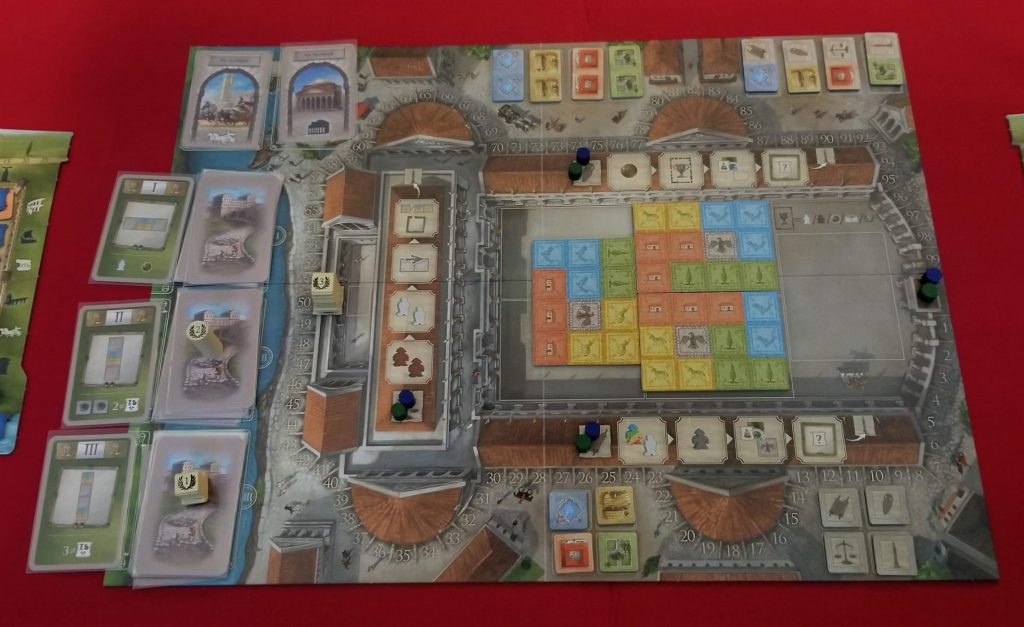
Now a start player is selected and given the starting player figure and the game begins.
Anatomy of a Round
Forum Trajanum is divided into 3 cycles, which are each divided into 4 rounds. At the end of a cycle, a scoring is performed. Each round always starts the same: 2 street cards are drawn from the current cycle’s street card deck and laid face up in the street card spaces. These street cards feature icons printed on them that correspond with icons printed on the player boards next to the rows and columns that make up the colonia. The revealed icons dictate which streets the players are allowed to remove colonia tiles from this round (this can be altered if a player gives up a tribune).
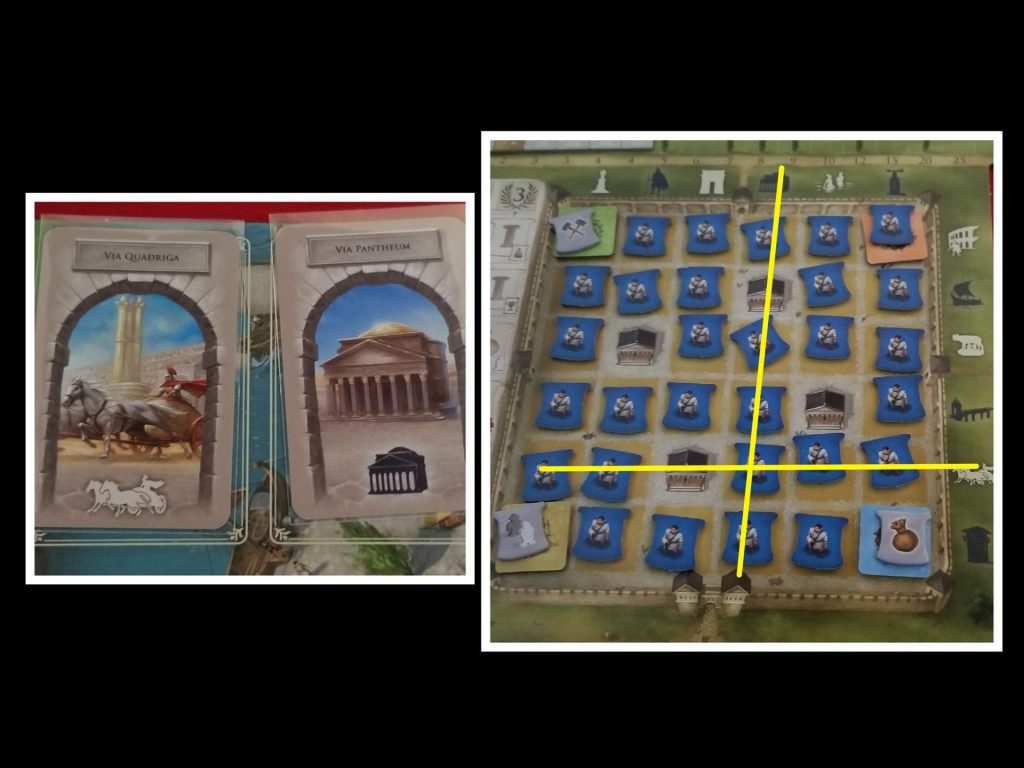
Once the two colonia tiles have been selected, they are placed face up at the bottom left of the player’s colonia. Then the player will select 1 of these tiles to keep and 1 to pass to the player on their left. Once this selection has been made, the player will choose 1 to play (receiving the associated benefits) and 1 to set aside. If the colonia tile set aside is their own color, it goes onto the envoy space at the bottom right of their colonia. If the unselected tile belongs to their neighbor, it is set to the right of the colonia and will come into play later on if the player who discarded it is unable to field 2 colonia tiles on their turn due to there being no legal tiles left on a matching street when the street cards are revealed. A player can also give up 2 tribunes if they’d like to use both of the tiles.
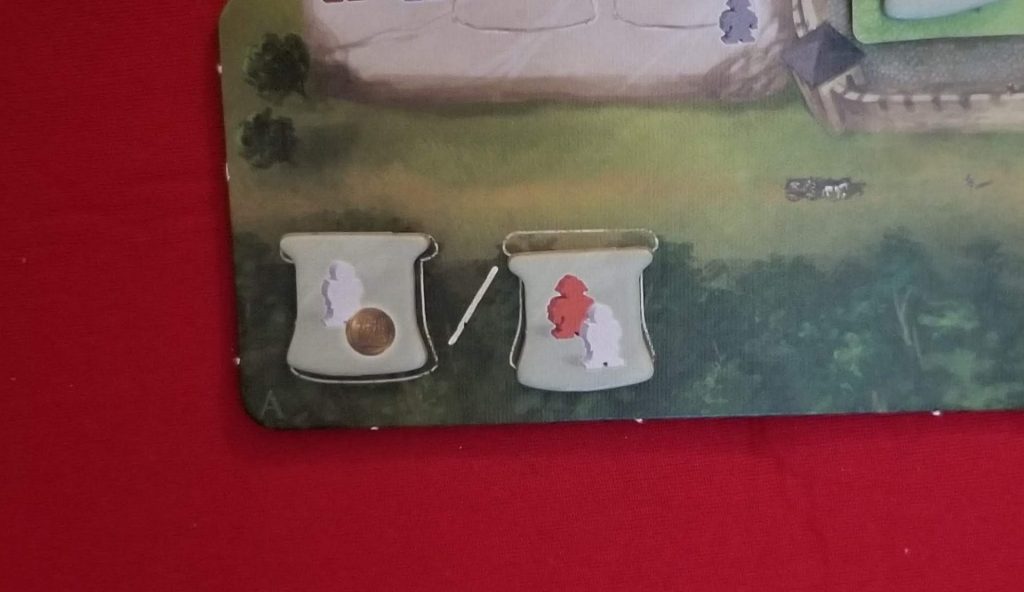
After the selected tile has been chosen and the benefits gained, the players will have an opportunity to construct within their colonia. There are two different types of buildings: colored buildings (red, green, yellow, or blue) and grey buildings that correspond to the 4 different areas of the forum (the aforementioned basilica, library, and market as well as the Triumphal column). Grey buildings will require the expenditure of grey builders while colored buildings will require the expenditure of workers matching the chosen color.
After adding buildings to their colonias, players will then have the opportunity to interact with the city board. If a grey building was built, they would move their marker up the corresponding track (if it was a basilica, market, or library) and then take the bonus. If they built a Triumphal column then will score points equal to the number printed above the Trajan symbol on the slider that was placed on the player board during setup plus one additional point for each citizen (located in the citizens area mentioned during setup) they have in their colonia. As the game progresses, this slider will move to the right increasing the victory point payout during scoring opportunities such as these.
If the constructed building was a colored building, the players will be able to send envoys to the city. In order to send envoys, the player must have available colonia tiles in their envoy space. The envoy is then placed into a square matching the color of the constructed building. If the colonia tile constructed was a double tile, the player could conceivably send 2 envoys. Having connected clusters of envoys in your own color equates into more points during scoring. Also, if you are the person that fills in the last square of a single color cluster you receive a one-time bonus of either a tribune, an assistant (used to change a worker’s color), a coin, a slider movement, or 2 victory points.
Once everyone has completed their actions for the round the starting player passes to the next player in clockwise position and a new round begins. After 4 rounds an end-of-cycle scoring is performed. Before I dive into that, though, let’s take a closer look at the colonia and its associated tiles.
Getting to Know Your Colonia
This is your colonia:

Along the top of the colonia (1) is the slider track. To the left of the colonia (2) is the citizen’s area. The bottom left hand corner (4) is where the round’s selected colonia tiles are placed. The bottom right hand corner (5) is where the envoy tiles are placed. The remainder of the real estate (3) is taken up by the colonia itself with icons at the top of each column and the end of each row that correspond to the street cards. At the 4 corners of the colonia are the construction cranes.
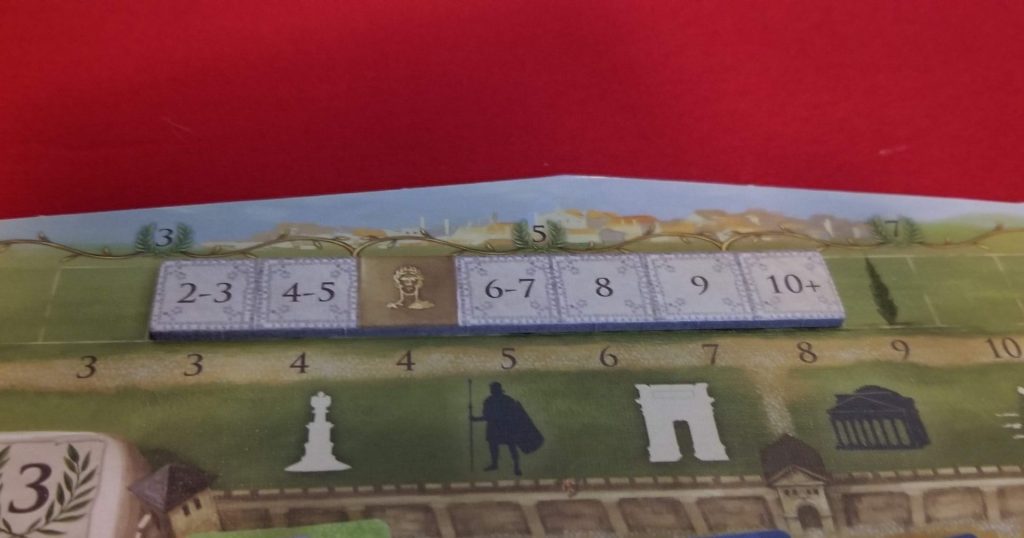
The slider bar: The slider bar is double-sided. Each player begins with their slider on its basic side, but this can be flipped over using one of the citizens. The only functional difference between the two sides is that the advanced side is worth more victory points than the basic side.
In the middle of the slider bar is a Trajan symbol. The point value for this symbol corresponds to the score track above the slider bar. In the image above, for example, the Trajan symbol would be worth 5 points since it is within the 5 point range.The numbers printed on the slider bar correspond with the score track below the slider bar. This score track is used in the end-of-cycle scoring.
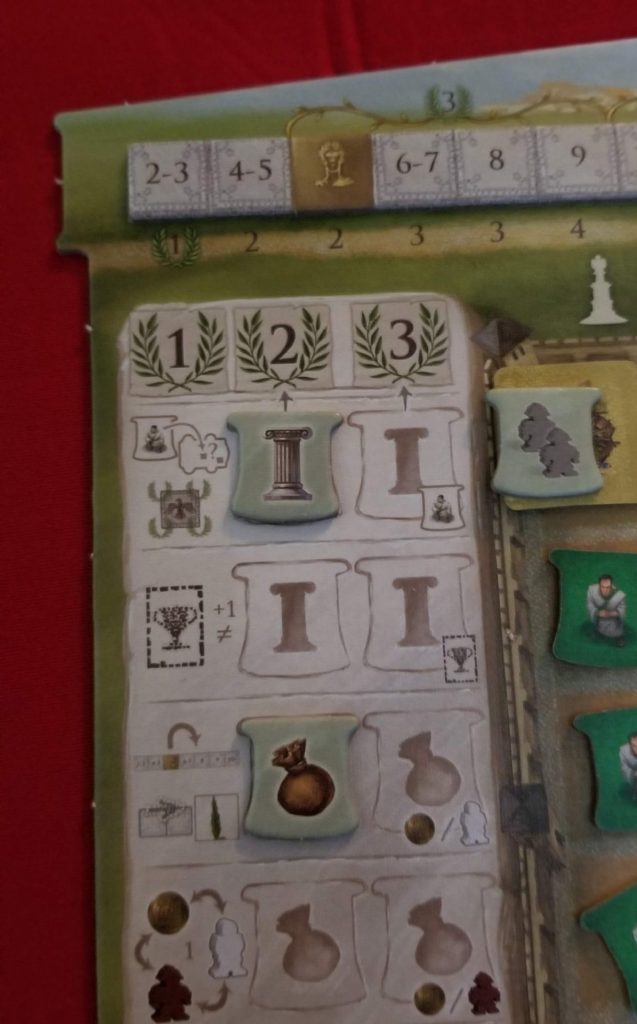
The citizens area: Tiles placed into this area confer different benefits depending upon a.) the type of citizen that has been placed, b.) where the citizen has been placed, c.) how many citizens are present in a single row, and d.) how many different grey tiles are present in a street row in your colonia during scoring.
a and b: There are 3 types of citizens (patricians, merchants, and craftsmen) and these are divided into 2 rows each with each row providing a different type of benefit. Patrician I and II allow you to score more points during forum scoring or score the one-time bonus for filling in a colored area with your envoys twice, respectively. Merchant I lets you flip your slider to its opposite side while Merchant II lets you convert money, craftsmen, and tribunes into one of the other things. The Craftsmen allow you to trade in assistants for either workers or builders.
c and d: Each citizen area column is worth a certain number of victory points. During the colonia portion of end-of-cycle scoring, the players will earn points equal to the highest valued citizen in a citizen row times the number of different grey tiles in the colonia row that’s next to it.
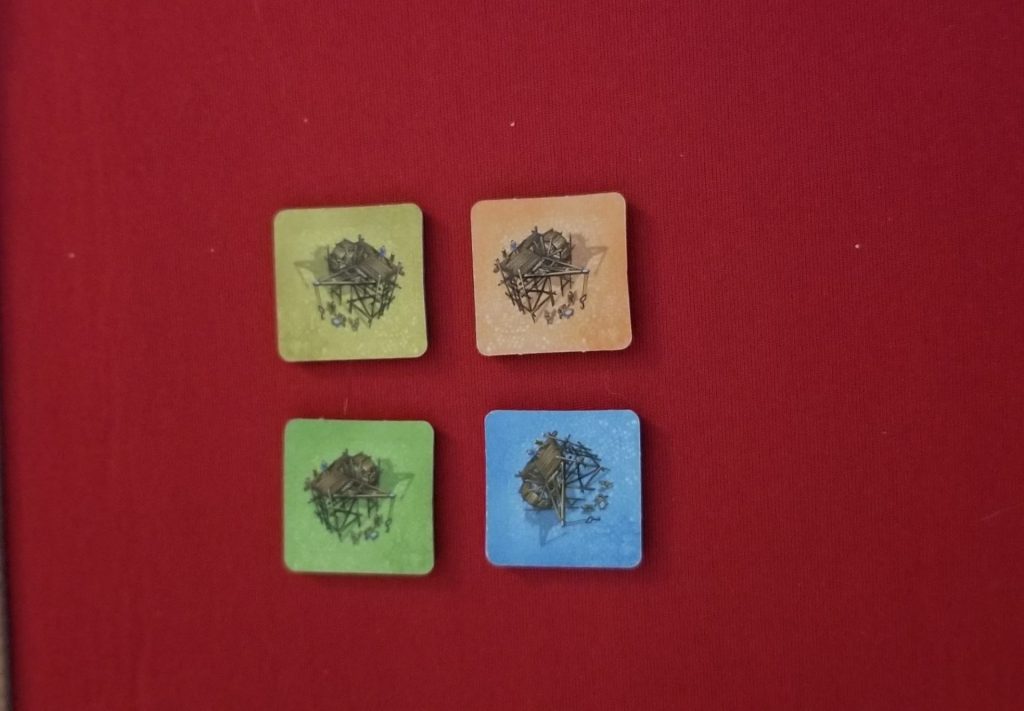
The construction cranes: There are four cranes, one in each color. Each crane provides a one-time end-of-cycle scoring value equal to the number of constructed buildings of the same color in the colonia times the number printed on the topmost Triumphal column piece. Once the crane is used for scoring, it gets flipped to its used side and can never be used again.
Scoring
I’ve mentioned several of the following scoring criteria in passing, but it bears repeating it all here in the same place. A large percentage of the scoring occurs at the end of each cycle, but there are a few ways that players can earn points before then:
- Collecting the 2 VP bonus for filling in the final square of a color cluster on the mosaic tiles
- Collecting the 2 VP bonus when moving your marker up the Market track
- Placing a grey Triumphal column tile into your colonia (as discussed earlier)
The end-of-cycle scoring occurs as follows:
- Pay citizens: Each player must pay 1 coin for each of its citizen rows or else those citizens get flipped face down and do not count for scoring purposes. Unpaid citizens’ unique abilities also become inactive as a result.
- Colonia scoring: Each row is scored and is worth points equal to the number of different grey tiles in the row times the highest value of citizens in the matching citizen row. If there are no citizen tiles present, then each different grey tile is worth 1 point each.
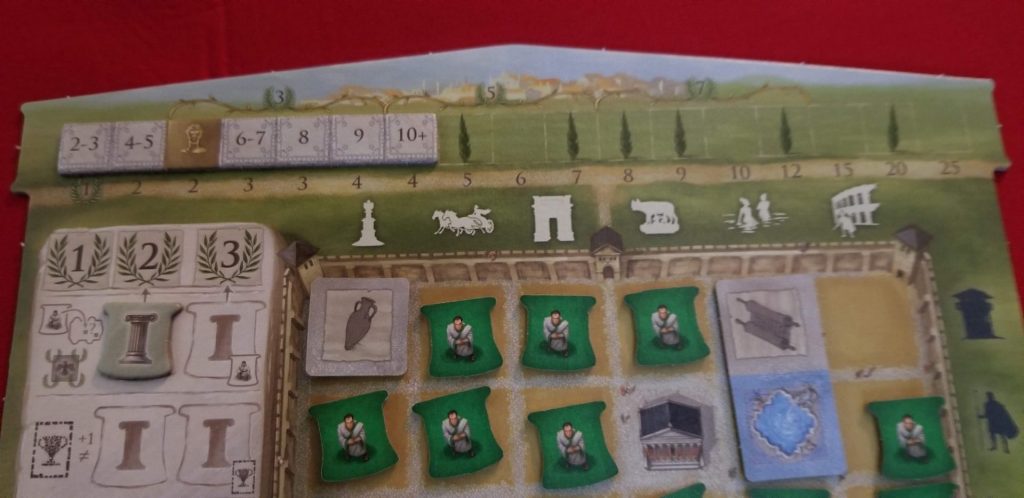
- Construction cranes: If there is a visible colored construction crane, then you score 3, 2, or 1 points (depending on which cycle you’re in) for each matching colored tile in your colonia.
- Forum scoring: Envoys orthogonally adjacent to eagle icons score 1 point each. Envoys on top of eagle icons score 2 each. Your largest cluster of connected envoys also scores points, how many depends on the position of the slider bar.
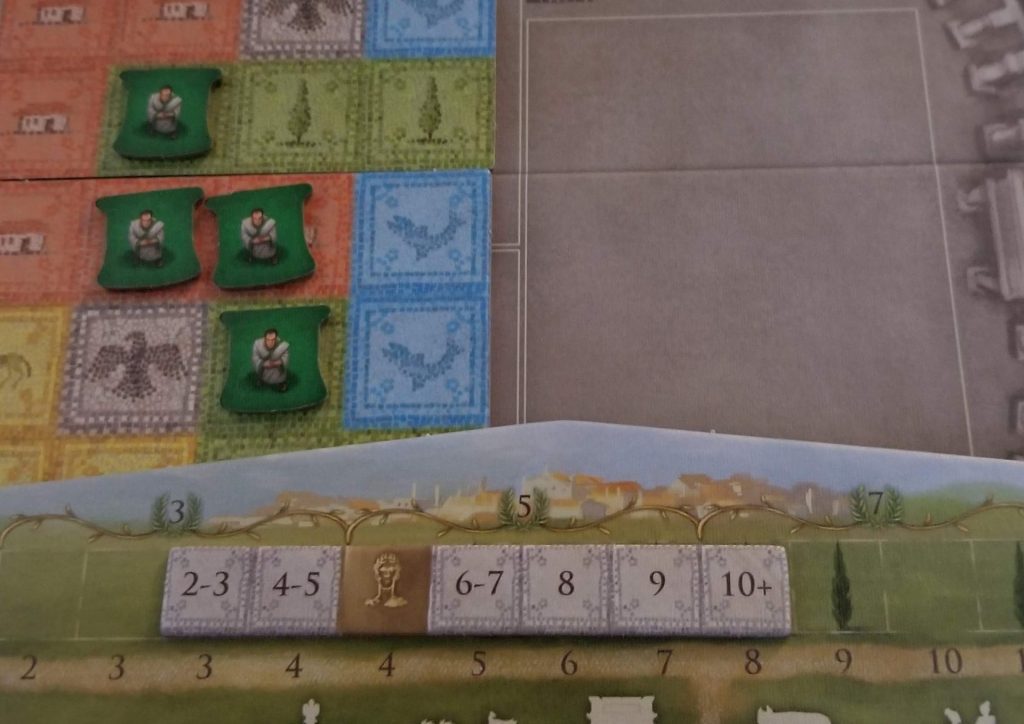
- Trajan scoring: Consult the Trajan card for the current cycle. The players score points for every instance they are able to fulfill the conditions in at least one of the two sections times the current value of the Trajan symbol on the slider bar.
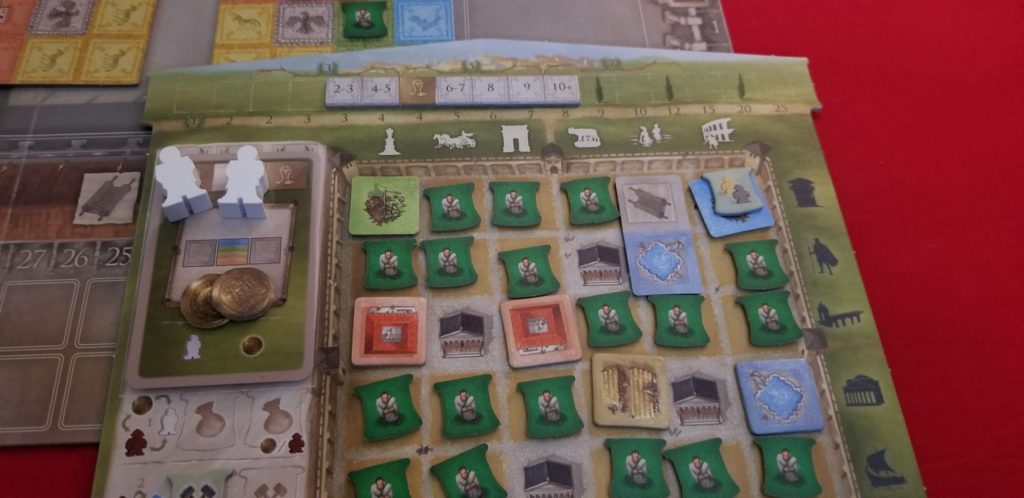
After the scoring phase of the third cycle is performed, the player with the most points wins the game.
Thoughts
The first thing that drew me to Forum Trajanum was Michael Menzel’s beautiful box cover illustration. In it we see an image of a man emanating an air of importance. This, I imagine, is the titular Emperor Trajan. His face emanates pride as he leans on the marble balustrade overlooking the scene in front of him. We can’t see it for ourselves, but judging by the epic architecture rising into the sky behind him we can imagine how magnificent it must be. I knew nothing of the Emperor Trajan or the Triumphal column (which still stands to this day) and forum which bears his name (portions of which still survive even now), but Menzel’s artwork had my curiosity piqued.
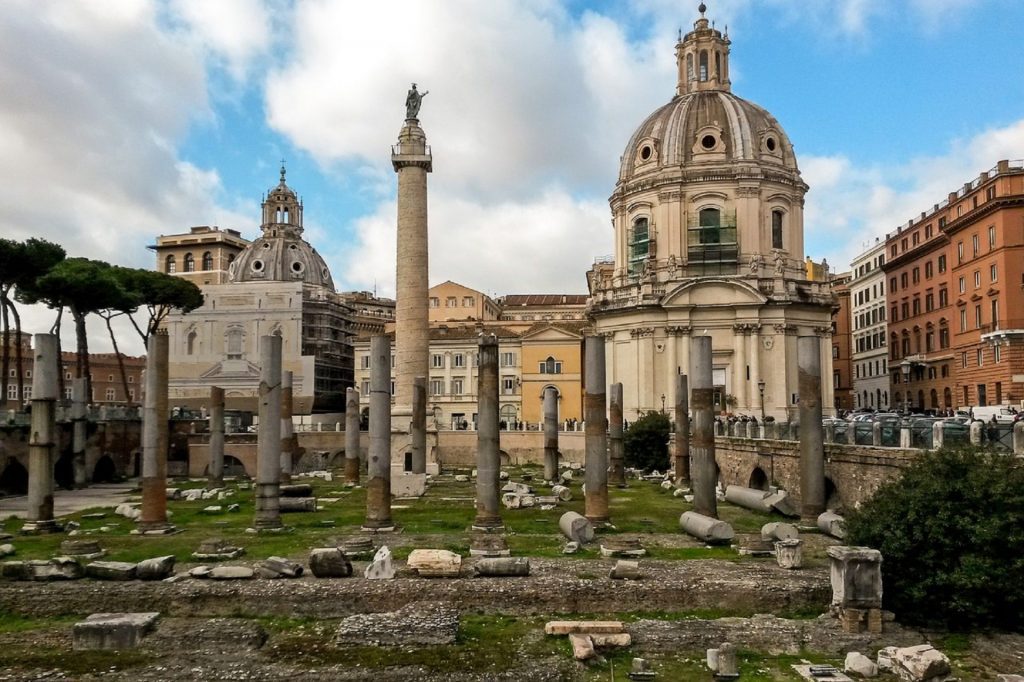
Delving further into the box, punching out all of the pieces (a task which seemed neverending) only served to stoke the fires of interest even more. I didn’t know anything at all about the game that I was unpacking, but I did know one thing: with Stefan Feld, the more pieces, the better. When I got to the rule book, I was momentarily taken aback. The rule book for Forum Trajanum is thick. Very, very thick. As I flipped through it, though, I realized that the rule book isn’t thick because of the game being absurdly complex, but rather because the rule book is actually several copies of the rule book in different languages all bound into one single volume. This is an approach to rule books which I don’t care for very much. It’s great if your native tongue happens to be at the beginning or the end of the rule book, but if it’s one of the languages sandwiched somewhere in the middle (which is exactly where English is in this one), it makes it a real pain to try to look up something mid-game (much less learning the game for the first time).
This issue, while irritating, doesn’t detract too much from the experience. It’s actually a pretty well-written rule book with plenty of illustrations and examples to help you along the way. There’s even a brief history lesson at the very end of it. While entirely unnecessary, it’s a fun little addition that I really enjoyed. Between the artwork, the game play, and the history lesson, Stefan Feld’s reverence for the subject matter is readily apparent in every aspect of the game.
Forum Trajanum is one of Stefan Feld’s strongest efforts to date. Each game presents the player with an interesting and intricate efficiency puzzle as they try to balance planning for the future while also trying to attend to the short term. From deciding which tiles to give away and which to keep in the draft to which buildings to construct and where, every decision that you make has long-lasting effects. Every decision is critical. For instance, which colonia tiles should you choose this turn? Do you remove tiles in such a way to make sure you’re capitalizing on the Trajan card’s scoring criteria or should you remove them so that you can perform double-builds to fill in the forum spaces? Also, which tiles should you keep in the draft? Any colonia tile not chosen is going to be given to your opponent. Do you choose to keep the one that would benefit them the most even though it may not benefit you or do you pass it on because the other one is of more benefit to you personally?
This leads into one of my only negatives about Forum Trajanum. In any game where you’re flipping over cards or tokens, the role that luck plays is undeniable. Sometimes things go your way and everything comes up roses. And sometimes it goes the other way. Nothing seems to go according to plan. Really great games give the players a lot of ways to mitigate these unfortunate circumstances to some extent. In The Castles of Burgundy, for instance, Stefan Feld gives the players the option to sacrifice die rolls to acquire worker tokens that can be used to manipulate future die rolls. It’s a brilliant method of handling the issue.
The sticky point in Forum Trajanum are the street cards. The game gives you the option to use tribunes to select tiles from streets other than the ones showing on the street cards for the current round, which is fine. However, this option is predicated on the assumption that you actually have any tribunes to use. If the tiles you are turning up don’t have tribunes on them and your opponents aren’t handing you any tiles with tribunes on them, then this option might as well not even exist. Aside from moving up the library and basilica tracks (which requires you to have obtained a builder at some point) or managing to be the person to fill in one of the mosaic tile areas, there is no other method of acquiring tribunes. At any time you can freely trade in multiple workers of the same type to acquire builders, but there is no such method for tribunes. While having trouble acquiring tribunes is an obstacle that can be overcome, it isn’t one that is easily overcome. It would be nice if it were a bit easier. This is all to say that Forum Trajanum features a lot of luck-driven elements and if you’re the type of gamer that really likes to feel that you’re in control at all times, this may not sit well with you.
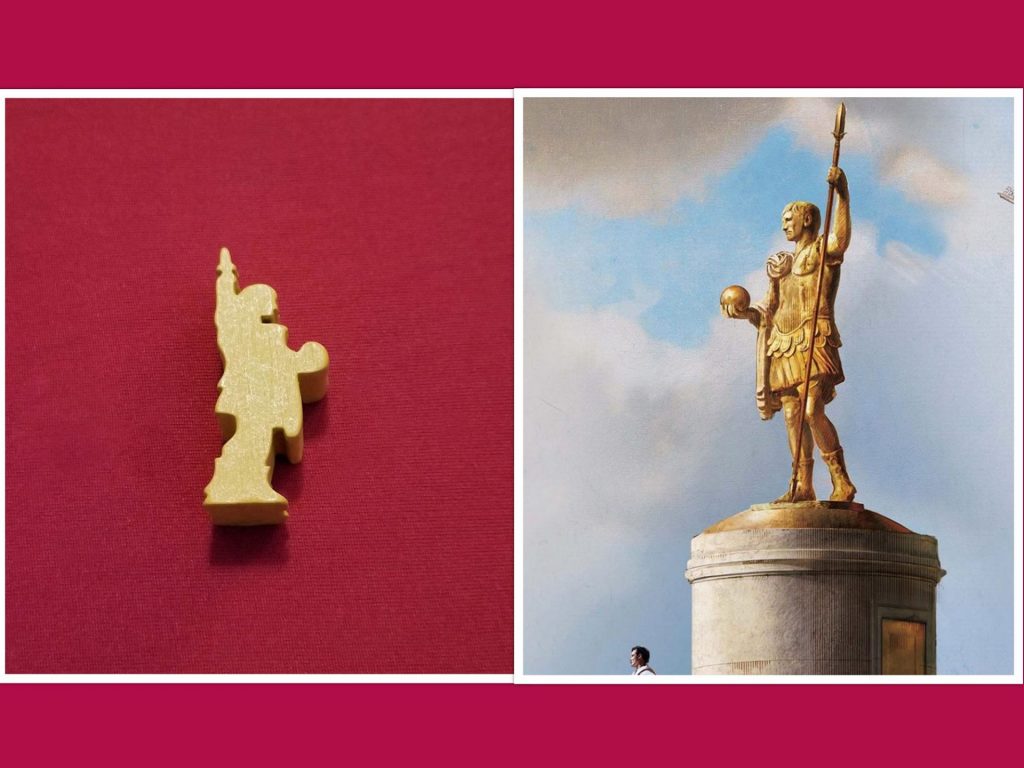
Aside from that, my only other gripe is about the game’s setup. It’s very convoluted and time consuming, so you’ll want to be sure you either try and get it ready to go before people begin arriving or you’ll want to enlist someone else to give you a hand. Chances are, if you’re trying to introduce a group of new people to the game and haven’t perfected the setup, by the time you’re finished getting everything all set up, eyes are going to be glazing over before you even get to begin teaching the game.
Overall, though, I love Forum Trajanum. It’s easily in my top 5 best Feld games of all time. I highly recommend it. If what you’ve read here has intrigued you, then it is worth mentioning that the game is playable on Yucata. Go give it a try. I know you’ll love it, too!


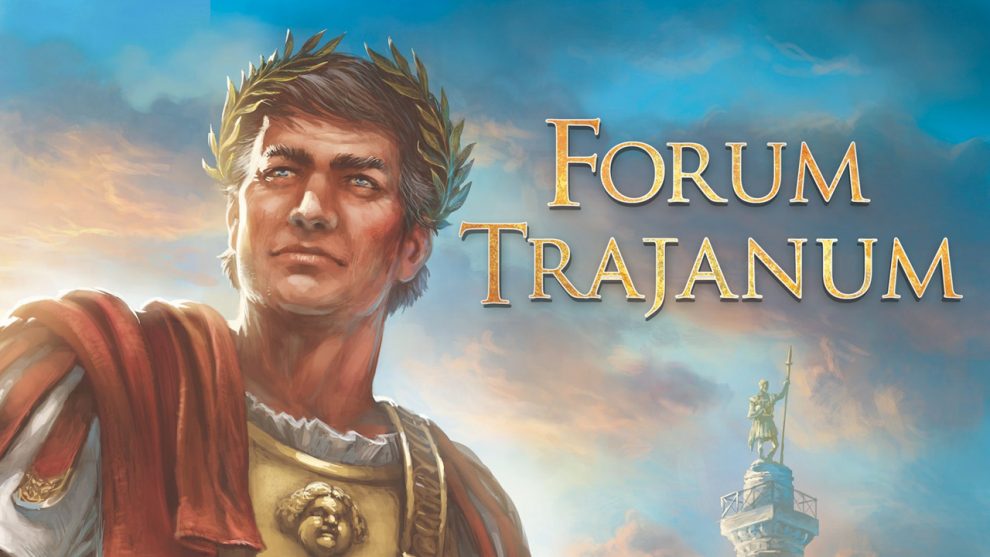

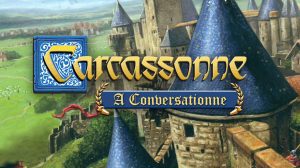






Super helpful review and guide, David! Thank you.